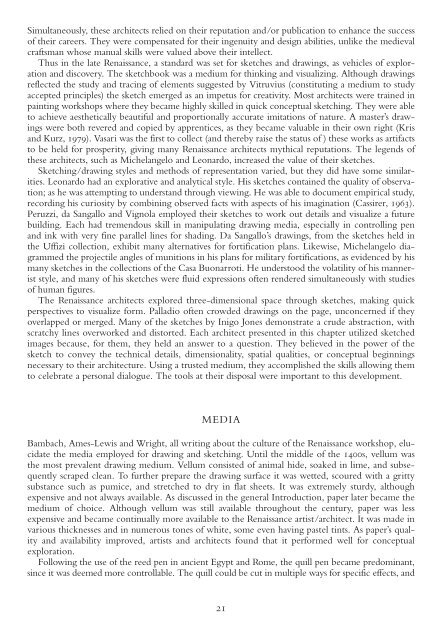Architect Drawings : A Selection of Sketches by World Famous Architects Through History
You also want an ePaper? Increase the reach of your titles
YUMPU automatically turns print PDFs into web optimized ePapers that Google loves.
Simultaneously, these architects relied on their reputation and/or publication to enhance the success<br />
<strong>of</strong> their careers. They were compensated for their ingenuity and design abilities, unlike the medieval<br />
craftsman whose manual skills were valued above their intellect.<br />
Thus in the late Renaissance, a standard was set for sketches and drawings, as vehicles <strong>of</strong> exploration<br />
and discovery. The sketchbook was a medium for thinking and visualizing. Although drawings<br />
reflected the study and tracing <strong>of</strong> elements suggested <strong>by</strong> Vitruvius (constituting a medium to study<br />
accepted principles) the sketch emerged as an impetus for creativity. Most architects were trained in<br />
painting workshops where they became highly skilled in quick conceptual sketching. They were able<br />
to achieve aesthetically beautiful and proportionally accurate imitations <strong>of</strong> nature. A master’s drawings<br />
were both revered and copied <strong>by</strong> apprentices, as they became valuable in their own right (Kris<br />
and Kurz, 1979). Vasari was the first to collect (and there<strong>by</strong> raise the status <strong>of</strong> ) these works as artifacts<br />
to be held for prosperity, giving many Renaissance architects mythical reputations. The legends <strong>of</strong><br />
these architects, such as Michelangelo and Leonardo, increased the value <strong>of</strong> their sketches.<br />
Sketching/drawing styles and methods <strong>of</strong> representation varied, but they did have some similarities.<br />
Leonardo had an explorative and analytical style. His sketches contained the quality <strong>of</strong> observation;<br />
as he was attempting to understand through viewing. He was able to document empirical study,<br />
recording his curiosity <strong>by</strong> combining observed facts with aspects <strong>of</strong> his imagination (Cassirer, 1963).<br />
Peruzzi, da Sangallo and Vignola employed their sketches to work out details and visualize a future<br />
building. Each had tremendous skill in manipulating drawing media, especially in controlling pen<br />
and ink with very fine parallel lines for shading. Da Sangallo’s drawings, from the sketches held in<br />
the Uffizi collection, exhibit many alternatives for fortification plans. Likewise, Michelangelo diagrammed<br />
the projectile angles <strong>of</strong> munitions in his plans for military fortifications, as evidenced <strong>by</strong> his<br />
many sketches in the collections <strong>of</strong> the Casa Buonarroti. He understood the volatility <strong>of</strong> his mannerist<br />
style, and many <strong>of</strong> his sketches were fluid expressions <strong>of</strong>ten rendered simultaneously with studies<br />
<strong>of</strong> human figures.<br />
The Renaissance architects explored three-dimensional space through sketches, making quick<br />
perspectives to visualize form. Palladio <strong>of</strong>ten crowded drawings on the page, unconcerned if they<br />
overlapped or merged. Many <strong>of</strong> the sketches <strong>by</strong> Inigo Jones demonstrate a crude abstraction, with<br />
scratchy lines overworked and distorted. Each architect presented in this chapter utilized sketched<br />
images because, for them, they held an answer to a question. They believed in the power <strong>of</strong> the<br />
sketch to convey the technical details, dimensionality, spatial qualities, or conceptual beginnings<br />
necessary to their architecture. Using a trusted medium, they accomplished the skills allowing them<br />
to celebrate a personal dialogue. The tools at their disposal were important to this development.<br />
MEDIA<br />
Bambach, Ames-Lewis and Wright, all writing about the culture <strong>of</strong> the Renaissance workshop, elucidate<br />
the media employed for drawing and sketching. Until the middle <strong>of</strong> the 1400s, vellum was<br />
the most prevalent drawing medium. Vellum consisted <strong>of</strong> animal hide, soaked in lime, and subsequently<br />
scraped clean. To further prepare the drawing surface it was wetted, scoured with a gritty<br />
substance such as pumice, and stretched to dry in flat sheets. It was extremely sturdy, although<br />
expensive and not always available. As discussed in the general Introduction, paper later became the<br />
medium <strong>of</strong> choice. Although vellum was still available throughout the century, paper was less<br />
expensive and became continually more available to the Renaissance artist/architect. It was made in<br />
various thicknesses and in numerous tones <strong>of</strong> white, some even having pastel tints. As paper’s quality<br />
and availability improved, artists and architects found that it performed well for conceptual<br />
exploration.<br />
Following the use <strong>of</strong> the reed pen in ancient Egypt and Rome, the quill pen became predominant,<br />
since it was deemed more controllable. The quill could be cut in multiple ways for specific effects, and<br />
21




